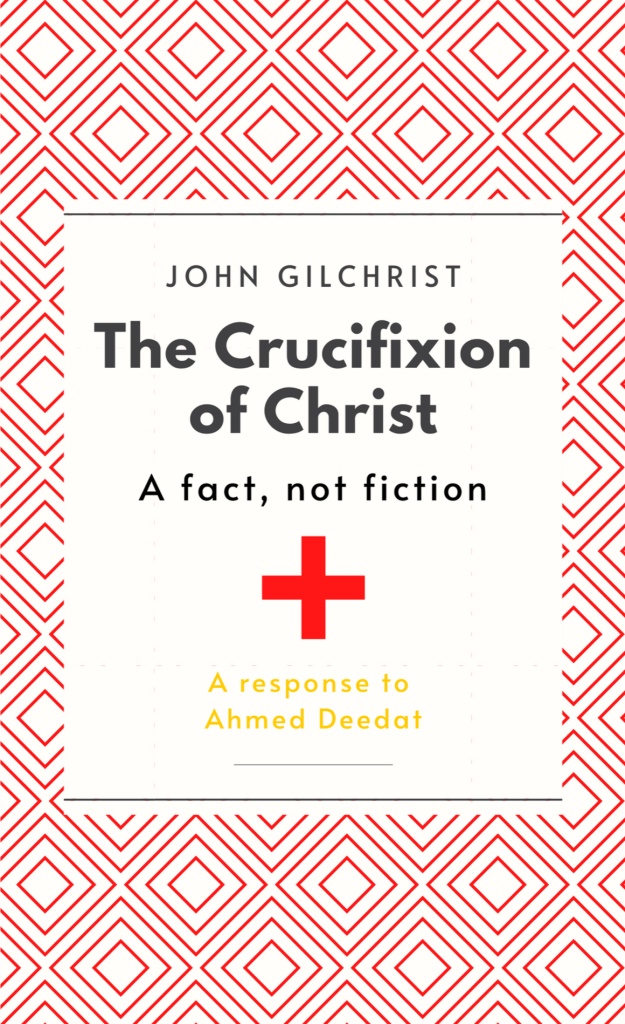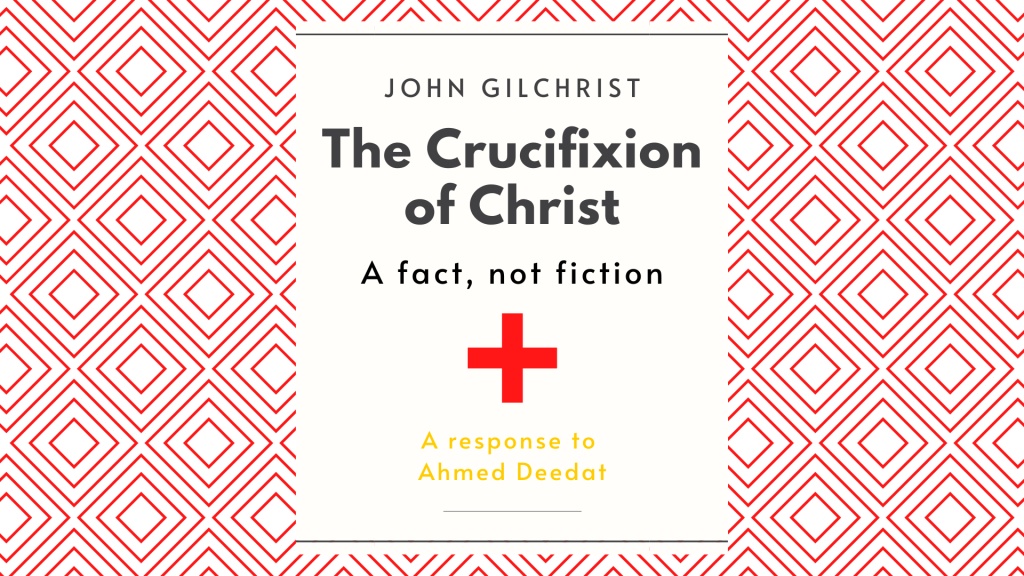Gospel Truths Deliberately Suppressed by Deedat
The Crucifixion of Christ: A Fact, not Fiction


Chapters
- Introduction
- Did Jesus Plan an Attempted Coup?
- The Image of Jesus in Deedat's Booklets
- Did Jesus Defend Himself at His Trial?
- The Theory that Jesus Survived the Cross
- Wild Statements in Deedat's Booklet
- Gospel Truths Deliberately Suppressed by Deedat
- Ahmed Deedat's Crucifixion Theory - A Muslim Perspective from Mohammed Bana
« Ch. 6 - Wild Statements in Deedat's Booklet
After all that has gone before it will not surprise our readers to find Deedat deliberately expunging words from the Bible that do not suit his purpose. On the day after Jesus' crucifixion the chief priests came to Pilate and in Matthew 27:62-64 we find a request made by them that the tomb should be sealed. It appears in Deedat's booklet as follows:
"Sir, we remember that that deceiver said ... Command, therefore, that the sepulchre be made secure until the third day, lest ... the LAST error shall be worse than the FIRST (error)". (Deedat, Crucifixion or Cruci-Fiction?, p. 42).
Twice in the quotation one finds three innocuous-looking dots as though something has been omitted because it is unimportant or irrelevant to the issues. Deedat's argument is that the Jews had suddenly realised that Jesus might still be alive and that they might have been "cheated" (p.42). They supposedly went to Pilate to get him to seal the sepulchre so that he could not escape and recover. Nevertheless, says Deedat, they were a day too late and their "last" error was to allow some of Jesus' disciples an opportunity "to render help to the wounded man" (p.43).
All that has happened here is that Deedat has had so forcibly expunge two clauses in the quotation referred to, not because they are considered unimportant, but because they refute his arguments completely and oblige the reader to discover a totally different picture of what was really transpiring. We shall record the whole quotation as it appears in a modern translation and shall place in capital letters the words wrenched out by Deedat and replaced with dots. The passage reads:
"Sir, we remember how that impostor said, WHILE HE WAS STILL ALIVE, 'AFTER THREE DAYS I WILL RISE AGAIN'. Therefore order the sepulchre to be made secure until the third day, lest HIS DISCIPLES GO AND STEAL HIM AWAY, AND TELL THE PEOPLE, 'HE HAS RISEN FROM THE DEAD', and the last fraud will be worse than the first". Matthew 27:62-64
We see immediately that the Jews did not for one minute believe that Jesus had come down alive from the cross. They went to Pilate, speaking of something Jesus had said WHILE HE WAS STILL ALIVE. These words can only be interpreted to mean that in their view Jesus WAS NO LONGER ALIVE. And they asked Pilate to seal the tomb, not because they feared a wounded man might recover, but because they feared his disciples would steal his body and proclaim that he HAD RISEN FROM THE DEAD. This is the obvious and plain meaning of the passage.
It is quite clear why Deedat omitted the clauses in italics. They disprove his theory completely. In fact we have found him regularly using this devious tactic in his booklets against Christianity. He distorts the Scriptures by wrenching some texts out of context which he feels can be tortured and perverted into serving his ends, and then casually ignores others completely which thoroughly discount his theories. Only in this case he has done this with just one passage, twisting some of its words to try and prove that the Jews thought Jesus was still alive, and expunging others which immediately show that this was not what was in their minds at all.
Surely any sincere Muslim can see that the whole theme of his booklet on the crucifixion is a contortion of the truth and that he has constantly warped the clear statements in the Gospels which testify unambiguously to the fact of the crucifixion, death and resurrection of Jesus Christ.
We might add that this is not the first time that we have come across publications published by Deedat's Centre where quotations from other writings are so mistreated. We would advise all readers to treat such quotations, where words are deleted and are simply replaced by three dots, with extreme caution. Invariably what is left has been twisted into yielding an interpretation that the whole quotation could not possibly yield.
The Jews had remembered Jesus' oft-repeated prophecy that he would rise from the dead after three days and they wanted to prevent any possible fulfilment of this prophecy - whether actual through his resurrection or contrived through the actions of his disciples. There is no warrant for Deedat's claim that the "Jews doubted his death" and that they "suspected that he had escaped death on the cross" (p. 79). The words omitted by him in the quotation on page 42 of his booklet show quite plainly that they were satisfied that he was indeed dead, but that they did not want his disciples to claim that he had been raised to life again.
Christians do not object to sincere critical analyses of their scriptures and convictions. In fact we welcome them in a way because they challenge us to be sure of what we believe and no true Christian would want to believe things that could not withstand critical analysis. We do sincerely take offence, however, at publications like Deedat's "Crucifixion or Cruci-Fiction?" which do nothing but pervert and distort the evidences for our faith and which are calculated to injure our feelings. We are persuaded that most Muslims would feel the same way about any Christian publication that distorted Islam the way Deedat degrades Christianity.
We are comforted to find that there are many Muslims in South Africa who have expressed their keen disapproval of such publications. A local Muslim magazine recently had this to say of Deedat's methods:
It is a well known fact throughout South Africa, even among Christian evangelical circles, that in so far as Mr. Ahmed Deedat in particular is concerned, the Muslim community of South Africa as a whole is not in total agreement with his method of propagating Islam. The Muslim Digest itself provides ample testimony for having been reluctantly compelled over the years to condemn in no uncertain terms the method of Mr. Deedat's propagation of Islam, especially amongst Christians. No less has Mr. Deedat been condemned by responsible Muslim religious bodies and individuals for the manner in which he propagates Islam that results in ill-will being generated against Muslims. (The Muslim Digest, Jul/Aug/Sept., 1984)
We shall close with a brief consideration of Deedat's argument that, if it can be proved that Jesus did not die on the cross, this proves he was not crucified at all. We have, in earlier publications, shown that such an obtruse argument arises from a predicament Deedat inflicts on himself with his theory that Jesus survived the cross. For the Qur'an plainly states that Jesus was "neither crucified nor killed" (Quran 4.157) and the overwhelming majority of Muslims throughout the world take this (obviously, in our view) to mean that Jesus was never put on the cross at all. I held a symposium with Deedat in Benoni on the subject "Was Christ Crucified?" in 1975 and the local newspaper thereafter summed up his argument perfectly by saying, "He was crucified, but did not die, he argued" As there are a number of discerning Muslims who have seen that his whole theory debases not only what the Bible says but also what the Qur'an says about the crucifixion, he is now trying to extricate himseelf from this predicament in which he has placed himself.
He therefore argues that "to crucify" means to "kill on a cross" and says that if a man survived the cross, this means he was never crucified. He shows that in English "to electrocute" means to kill by an electric bolt and that "to hang" means to kill by hanging. Therefore he says that in English "to crucify" must also mean to "kill on a cross" and claims that he cannot be held responsible for a deficiency in the English language which does not have alternative words for an attempted crucifixion, electrocution or hanging.
In saying this be misses the point completely. The narratives of the crucifixion in the Bible were originally written in Greek and more than a thousand years were to pass before they would ever be translated into English. The important point is not what "to crucify" might mean in Deedat's understanding of English but what it meant in Greek when the Gospels were first written. One quotation will suffice to show that "to crucify" in Biblical times meant simply "to impale on a cross". The Apostle Peter once declared to a Jewish multitude:
"This Jesus, delivered up according to the definite plan and foreknowledge of God, you crucified and killed by the hands of lawless men" Acts 2:23
The verse clearly reads you crucified and killed, meaning obviously, "you impaled him on a cross and you killed him there" Therefore it is absurd to suggest that if a man was not actually killed on cross, this means he was never crucified. If "to crucify" only eant to kill on a cross, Peter would just have said "you crucified him", but by adding "and killed", he shows plainly that "to crucify" meant simply to impale on a cross. Deedat remains in th predicament of advocating that Jesus was indeed crucified but did not die - a theory repugnant to true Christians and Muslims alike.
One struggles to follow the reasoning behind Deedat's line of approach. He seems to think that if he can prove that Jesus did not die on the cross, this proves that the Qur'an is true when it says he was not killed by the Jews. But how can the point possibly stand when the whole argument of necessity concedes the other thing the Qur'an denies - the actual crucifixion of Jesus? There just does not seem to be any logic in his argument at all.
Ch. 8 - Ahmed Deedat's Crucifixion Theory - A Muslim Perspective from Mohammed Bana »